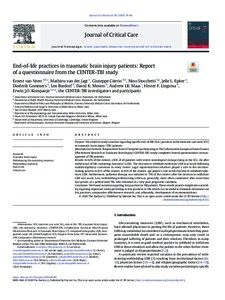End-of-life practices in traumatic brain injury patients: Report of a questionnaire from the CENTER-TBI study
Gommers D; Maas AIR; van Veen E; Kompanje EJO; the CENTER-TBI investigators and participants; Epker JL; Stocchetti N; Lingsma HF; Menon DK; Citerio G; Burdorf L; van der Jagt M
https://urn.fi/URN:NBN:fi-fe2021042823026
Tiivistelmä
Purpose: We aimed to study variation regarding specific end-of-life (EoL) practices in the intensive care unit (ICU) in traumatic brain injury (TBI) patients.
Materials and methods: Respondents from 67 hospitals participating in The Collaborative European NeuroTrauma Effectiveness Research in Traumatic Brain Injury (CENTER-TBI) study completed several questionnaires on management of TBI patients.
Results: In 60% of the centers, ≤50% of all patients with severe neurological damage dying in the ICU, die after withdrawal of life-sustaining measures (LSM). The decision to withhold/withdraw LSM was made following multidisciplinary consensus in every center. Legal representatives/relatives played a role in the decision-making process in 81% of the centers. In 82% of the centers, age played a role in the decision to withhold/withdraw LSM. Furthermore, palliative therapy was initiated in 79% of the centers after the decision to withdraw LSM was made. Last, withholding/withdrawing LSM was, generally, more often considered after more time had passed, in a patient with TBI, who remained in a very poor prognostic condition.
Conclusion: We found variation regarding EoL practices in TBI patients. These results provide insight into variability regarding important issues pertaining to EoL practices in TBI, which can be useful to stimulate discussions on EoL practices, comparative effectiveness research, and, ultimately, development of recommendations.
Kokoelmat
- Rinnakkaistallenteet [19250]
